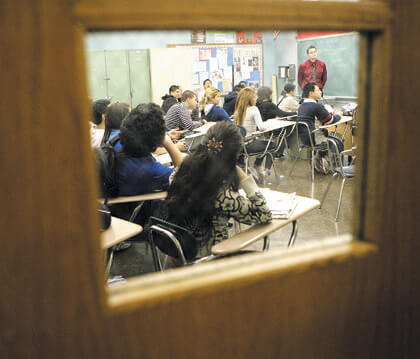By Anna Gustafson
The new five−year capital plan from the city Department of Education calls for more than 12,000 classroom seats and 16 new schools to be built in Queens — a number city officials say will help the borough deal with overcrowding, but which the director of Class Size Matters called “breathtakingly inadequate.”
City budget cuts to education, and an anticipated slash in state aid, prompted DOE officials to craft the $11.3 billion plan that is $1.7 billion less than the $13 billion allotted for the 2004−09 plan. Mayor Michael Bloomberg has suggested cutting education funding by $586 million over two years.
Unknown still is how decreases in state aid will affect city schools. Gov. David Paterson has said mid−year cuts to school aid and steep cuts to education aid later in the year may be inevitable with lawmakers facing a $12.5 billion budget shortfall next year. Still, state Sen. Frank Padavan (R−Bellerose) has said he plans to fight any cuts to education.
DOE spokesman William Havemann said that while fewer classrooms are planned in the new document — due in part to rising construction costs, Queens is slated to see more seat openings than any other borough.” Queens has done well in this plan,” Havemann said. “… We’re creating an unprecedented number of seats across the city that will reduce overcrowding.”
Leonie Haimson, executive director of Class Size Matters, a nonprofit that advocates for smaller classes, said the city needs about seven times more than the 25,000 seats proposed in the new capital plan.
“The administration clearly does not care enough about providing our students with a decent education, from the evidence provided in this plan,” Haimson said. “It would provide only 25,000 new seats, with 8,000 of those rolled over from the last plan, while according to our analysis, there is a need for more than 160,000.”
According to a recent report issued by Class Size Matters, the United Federation of Teachers, the Center for Arts Education and the Manhattan Task Force on School Overcrowding, Queens schools need nearly 54,000 additional seats to address overcrowded classrooms, Haimson said, which poses safety issues.
City education officials scoffed at the report, titled “A Better Capital Plan” and released at the end of October. Havemann said it would cost too much to build the 167,000 seats in what he called an under−used school system experiencing a population decrease.
“Their main assertion is we should create 167,000 new seats, and they say this would cost about $12.7 billion,” said Havemann. “Creating that would cost more than three times that. When you build new schools, you have to hire new teachers. They seriously low−balled the amount it would cost.”
Havemann added that the city school system is currently functioning at 85 percent capacity.
“So the school system as a whole is under−utilized,” Havemann said. “Creating another 167,000 seats when enrollment is declining is not a wise policy, regardless of the fact that it would cost upward of $40 billion. There are certain neighborhoods where schools are under−utilized and certain neighborhoods where schools are overutilized. We’ve worked extremely hard to reduce overcrowding in neighborhoods where overcrowding is an issue. We’re working to build new schools in those neighborhoods.”
Though Havemann said Queens schools are currently functioning at about 93 percent utilization — a drop from the 101.6 utilization Queens schools were at five years ago, parents said they frequently encounter issues of overcrowding.
“In District 24, we got over 5,000 seats in the capital plan and we still have terrible overcrowding,” said Marge Kolb, a Woodside parent who has a second− and sixth−grader in the school system. “We have a school that buses its entire kindergarten to Fresh Meadows. There’s schools that don’t have libraries, that don’t have gymnasiums, that have lunch at 9:45 in the morning.”
Havemann said parents should expect to see overcrowding continue to decrease in coming years.
“We’re building seats in Queens, in the Bronx, throughout the city,” he said. “The process for building schools takes a long time. We’re also creating enrollment policies that will evenly distribute students across schools. That means imposing a cap on a school if it’s becoming enrolled.”



































